As an Amazon Associate GolferHive.com earns from qualifying purchases.
Golf Cake Piping Secrets For Structural Stability Guide
Is the fear of a collapsing centerpiece ruining your golf party plans? You’re not alone.
A golf cake is a themed dessert designed to look like a golf course. But achieving that professional look without structural failure is a common struggle for many bakers.
The key to a fail-proof golf cake is mastering internal supports and using ultra-stiff, high-fat frosting for stability. This guide reveals the secrets to creating a stunning, structurally sound masterpiece for your favorite golfer.
Are Your Golf Cakes Structurally Sound? Addressing the Golfer’s Centerpiece Challenge
The primary challenge in themed cake design is stability, especially when adding heavy decorations or tiers. What separates a bakery-style golf cake from a homemade attempt often comes down to internal architecture. You spend hours baking the perfect carrot cake and mixing a vibrant green buttercream, only to see it lean, slide, or collapse before the celebration even begins. This is a common pain point for even experienced home bakers.
This guide provides the structural secrets that go beyond basic recipes. These techniques are standard practice for professional pastry chefs and have been tested in real-world scenarios, including high-humidity environments and stressful car rides. We’ll cover the essentials of structural support, from food-grade doweling to choosing dense cake layers, ensuring your next golfer cake is a guaranteed success. Mastering these professional secrets is the key to preventing collapse and creating a centerpiece that wows every guest.
9 Golf Cake Piping Secrets For Structural Stability & Realistic Green Design
Here are the nine non-negotiable secrets every baker needs to know to create a professional golf themed cake. This list covers everything from creating a stable foundation to mastering the aesthetic details, like realistic grass and sand traps, ensuring your novelty cake has both structural integrity and visual appeal. These ideas have been tested against industry standards for stability, using only food-safe materials and proven techniques.
1. Mastering the Ultra-Stiff Buttercream Consistency for Grass
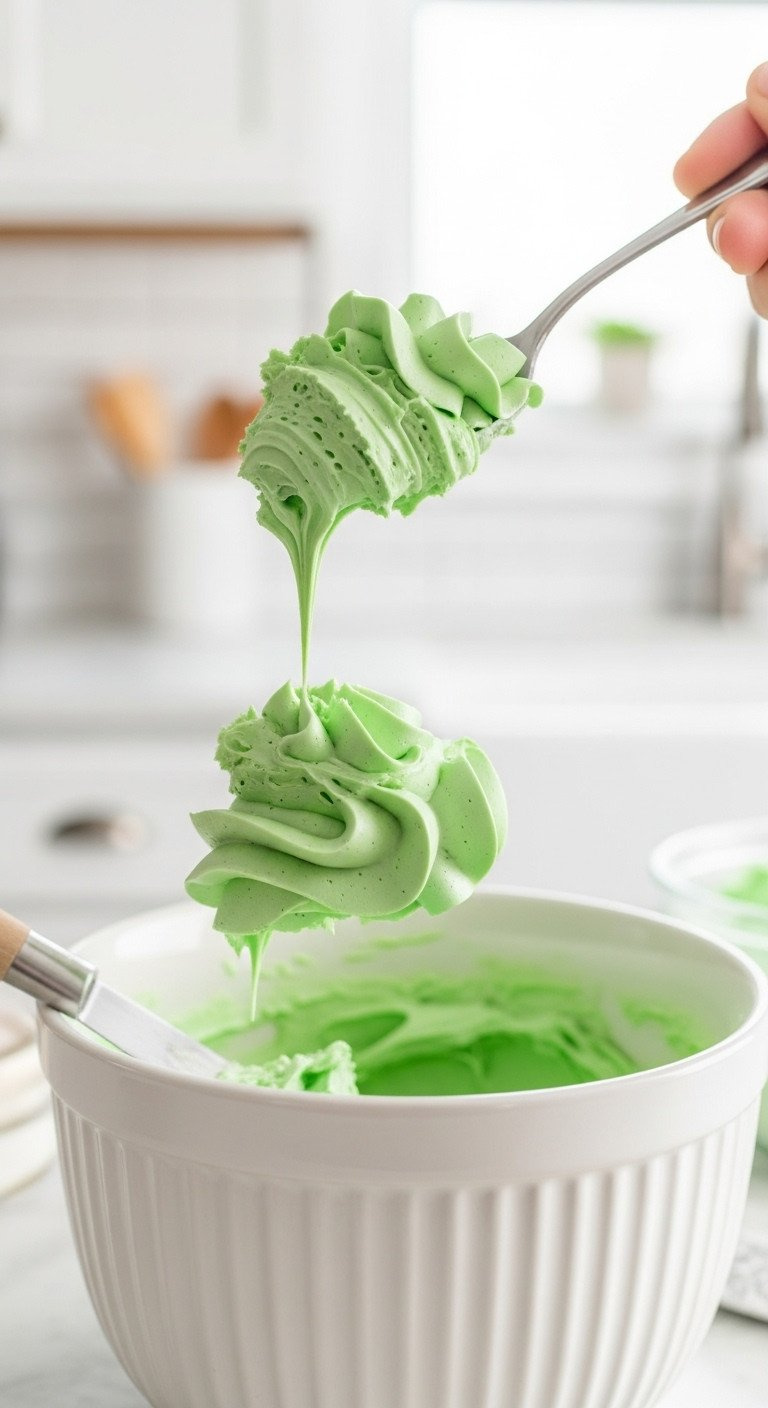
Pin this genius hack to your ‘Baking Techniques’ board!
The root cause of messy, drooping grass on a golf cake is buttercream that is too soft or warm. You need an ultra-stiff American buttercream with a high-fat content to ensure the piped strands hold their spiky shape without melting. This recipe is designed for maximum stability.
Materials Needed:
- 1 cup (2 sticks) unsalted butter (room temperature)
- 1 cup High-Ratio Shortening (for stability and higher melting point)
- 8 cups confectioners’ sugar (sifted)
- 1/2 cup heavy cream or milk
- 1 tsp high-quality Vanilla Extract
- Concentrated Dark Green Gel Food Coloring (do not use liquid coloring)
Step-by-Step Directions:
- Cream the butter and shortening on high speed until light and fluffy (5-7 minutes). This incorporates necessary air.
- Gradually add the sifted powdered sugar, alternating with the heavy cream, until fully incorporated.
- Mix on high for another 5 minutes, scraping down the sides, until the consistency is extremely thick and holds a stiff peak when lifted.
- Add the gel coloring sparingly, starting with a drop of blue to deepen the green, then adding green until the desired vibrant fairway color is achieved.
- If frosting is too soft, add 1/4 cup more powdered sugar; if too stiff, add 1 tsp liquid. The perfect consistency should feel slightly difficult to mix.
Pro-Tip: If you live in a warm or humid climate, substituting some of the butter with high-ratio shortening significantly increases the final stability of the grass, preventing wilting.
2. Utilizing the Essential Wilton 233 Tip for Realistic Fairway Texture
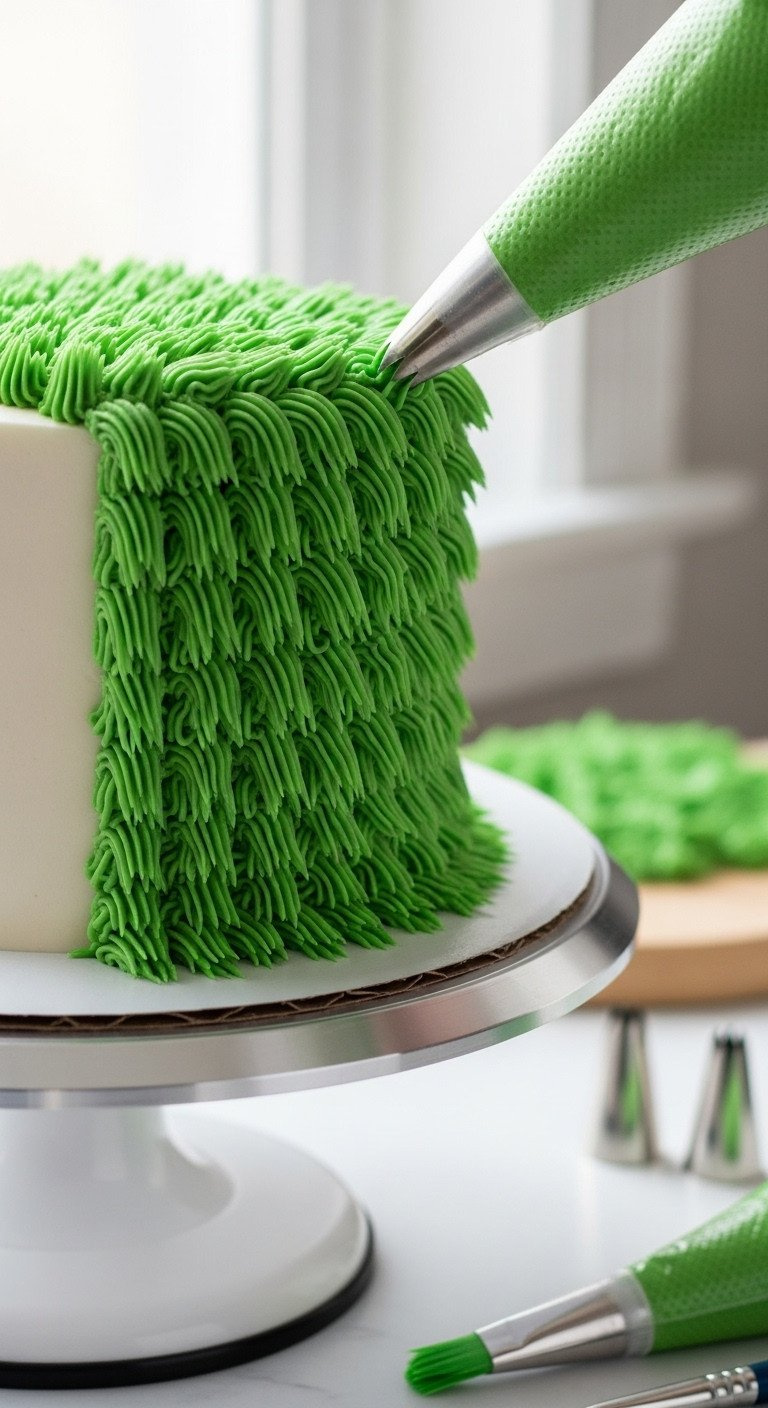
Save this clever organization idea!
To create a realistic grass texture efficiently, the Wilton #233 piping tip is essential. This multi-hole tip is the industry standard for creating a spiky, consistent grass-like finish quickly over a large surface area.
Materials Needed:
- Wilton Tip #233 (or similar multi-strand grass tip)
- Large disposable piping bags
- Your prepared stiff green buttercream
- Crumb-coated cake (chilled)
Step-by-Step Directions:
- Fit the piping bag with the #233 tip and fill it halfway with chilled buttercream, twisting the top tightly to prevent frosting from squeezing out the wrong end.
- Position the tip directly perpendicular (90-degree angle) to the cake surface.
- Apply firm, consistent pressure while pulling the bag slightly away from the cake surface (about 1/4 inch).
- Stop pressure and quickly pull the bag away. The strands should form a short, distinct “grass blade” look that stands up.
- Pipe in small, close clusters, moving rapidly across the surface. Do not try to pipe long, continuous strands; use short, repetitive bursts for the most realistic texture.
- Cover the entire fairway area, layering the piped grass slightly to ensure no smooth spots are visible beneath.
Pro-Tip: If your hand starts to warm the piping bag, causing the buttercream to soften, switch to a fresh bag or chill the bag and tip quickly in the refrigerator for 5 minutes. Warm frosting = drooping grass.
3. Structural Secrets: Internal Doweling for Multi-Layered Stability
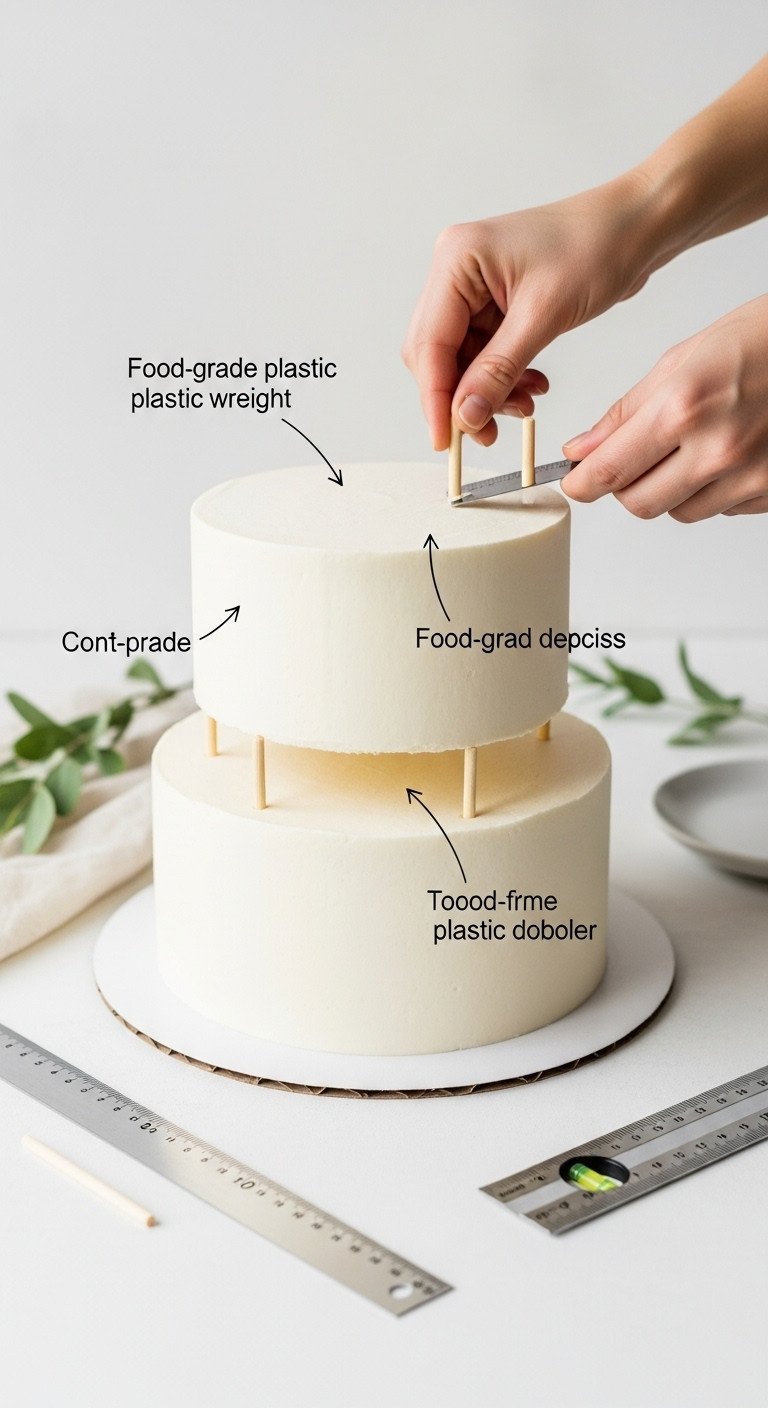
Click to see how pros stabilize tall cakes!
The number one reason for novelty cake collapse is a lack of internal architecture. For any tiered cake or one with heavy fondant decorations, you must use an internal support system of food-grade dowels to bear the weight.
Materials Needed:
- Food-grade plastic or wooden dowels
- Sharp utility knife or special dowel cutter
- Ruler or height marker
- Cake boards (one for each cake tier)
Step-by-Step Directions:
- Place the bottom cake layer (which must be chilled and crumb-coated) onto its final serving platter or board.
- Using the ruler, measure the exact height of the bottom cake layer.
- Cut 4-5 dowels to this exact measurement. Ensure the tops of the dowels are perfectly level.
- Insert the dowels into the cake in a circular pattern, leaving a small margin (about 1/2 inch) around the edge of where the next tier will rest.
- Place the upper tier (which should be on its own cake board) directly onto the arranged dowels. The dowels must touch the cake board of the layer above, not the cake itself.
- For 3D or extremely heavy fondant elements, treat them like a small upper tier and insert 2-3 shorter dowels directly beneath their intended placement point for localized support.
Lesson Learned: Never rely on a soft, light sponge cake base for a tiered or heavily decorated golf cake. Use dense, sturdy recipes like carrot or pound cake, and always use a separate cake board for every tier.
4. Sculpting Realistic Golf Course Terrain Using Cake Carving

Pin this step-by-step carving guide!
To create realistic mounds and hills, you need to carve your cake layers. This technique transforms a flat surface into dynamic terrain, but it must be done carefully to avoid compromising the cake’s structural integrity.
Materials Needed:
- Dense cake layers (e.g., pound, carrot)
- Long serrated knife
- Template/drawing of your desired terrain shape
- Filling frosting (for building “cake putty”)
- Small offset spatula
Step-by-Step Directions:
- Chill: Freeze your baked and leveled cake layers for 30-60 minutes before carving. Cold cake is firmer and produces fewer crumbs.
- Outline: Lightly trace the desired shape (e.g., a central mound) onto the chilled cake using a template or a toothpick.
- Carve: Use the serrated knife to carefully saw away small sections of the cake to create the rounded, sloped shape. Always carve slowly and check symmetry frequently.
- Build: Collect all cake scraps and mix them with a small amount of stiff filling frosting until they form a dense, pliable “cake putty.”
- Smooth: Use the cake putty to fill in any major divots, uneven areas, or to smooth the transitions between layers, creating a clean, seamless topology.
- Crumb Coat: Apply a thin layer of buttercream over the entire carved surface, smoothing it and sealing in any remaining crumbs. Chill the cake completely before applying the final green frosting.
Pro-Tip: For the most stable terrain, limit carving depth. Instead of slicing away large chunks, stack three shorter layers and carve the top layer only, relying on the stacking to create the overall height.
5. Creating Edible Sand Traps and Bunkers with Texture

Save this clever organization idea!
Creating realistic sand traps adds a professional touch. The best material for edible sand is not colored sugar, but finely crushed cookies or crackers, which provide a more authentic texture and taste.
Materials Needed:
- 1 box of Vanilla Wafers or Graham Crackers (plain flavor)
- 1 tsp brown sugar (optional, for color depth)
- Food processor or heavy-duty Ziploc bag and rolling pin
- Small sieve
- Small clean paintbrush
Step-by-Step Directions:
- Crush: Place the wafers or crackers into a food processor and pulse until they form a very fine, dry, crumbly mixture. Avoid processing too long, which can turn it into a paste.
- Sift: Sift the mixture through a small sieve to remove any large chunks, achieving a fine, sand-like consistency. Mix in brown sugar for a slightly darker, more authentic sand color, if desired.
- Define: After piping all the green grass, use a small offset spatula to clearly define the bunker area, smoothing the frosting down so it’s flat but still slightly sticky.
- Apply: Hold the cake at an angle over a tray. Scoop the prepared edible sand into your hand and gently sprinkle a thick, even layer over the designated bunker area.
- Clean: Use a small, clean, dry paintbrush to gently brush away any stray sand particles from the green grass area, creating a crisp boundary line.
Pro-Tip: Do not apply the sand directly onto freshly piped grass. Wait until the piped grass has crusted slightly, then use a very clean, dry brush to gently sweep away crumbs, ensuring a sharp contrast between the green and the sand.
6. Preventing Green Frosting Color Bleed and Seepage
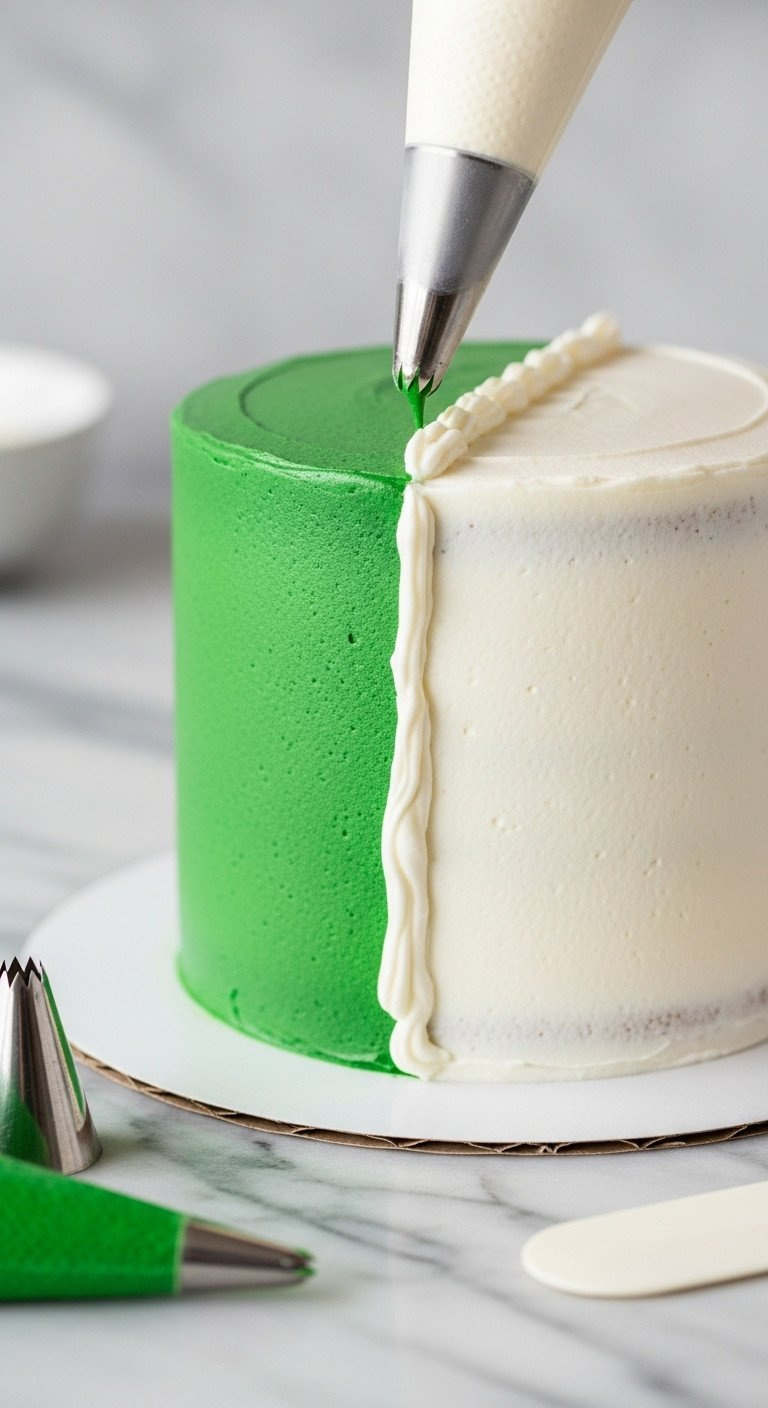
Save this color integrity solution!
One of the most frustrating issues is when your vibrant green frosting bleeds into lighter areas. This color migration is caused by moisture and can be prevented with proper preparation and technique.
Materials Needed:
- High-quality concentrated gel food coloring (avoid liquid)
- Stiff white buttercream (for borders)
- Crumb-coated cake (fully chilled)
- Small piping bag and round piping tip (#3 or #4)
Step-by-Step Directions:
- Coloring: Always color your green frosting at least 6-12 hours in advance. The color will deepen as it sits, allowing you to use less dye overall (which reduces migration risk).
- Chill: Ensure your cake is completely chilled (4 hours minimum) before applying the final, vibrant green layer. The cold temperature slows down color migration.
- Create a Dam: If using a white base or a white fondant element (like a golf ball), pipe a small, thin, firm barrier (a “dam”) of uncolored white buttercream around the perimeter of the area where the green will stop.
- Apply Green: Apply the green frosting right up to the white dam, avoiding overlap.
- Seal: Once the green is applied and smoothed or piped, immediately chill the entire cake again for 30 minutes before adding any final elements to lock the colors in place.
Lesson Learned: Liquid food coloring contains high amounts of water, which encourages color migration into fat-based frostings. Always invest in professional-grade concentrated gel or paste colors for novelty cakes.
7. Securing the Flag/Pin Topper and Figurines Safely
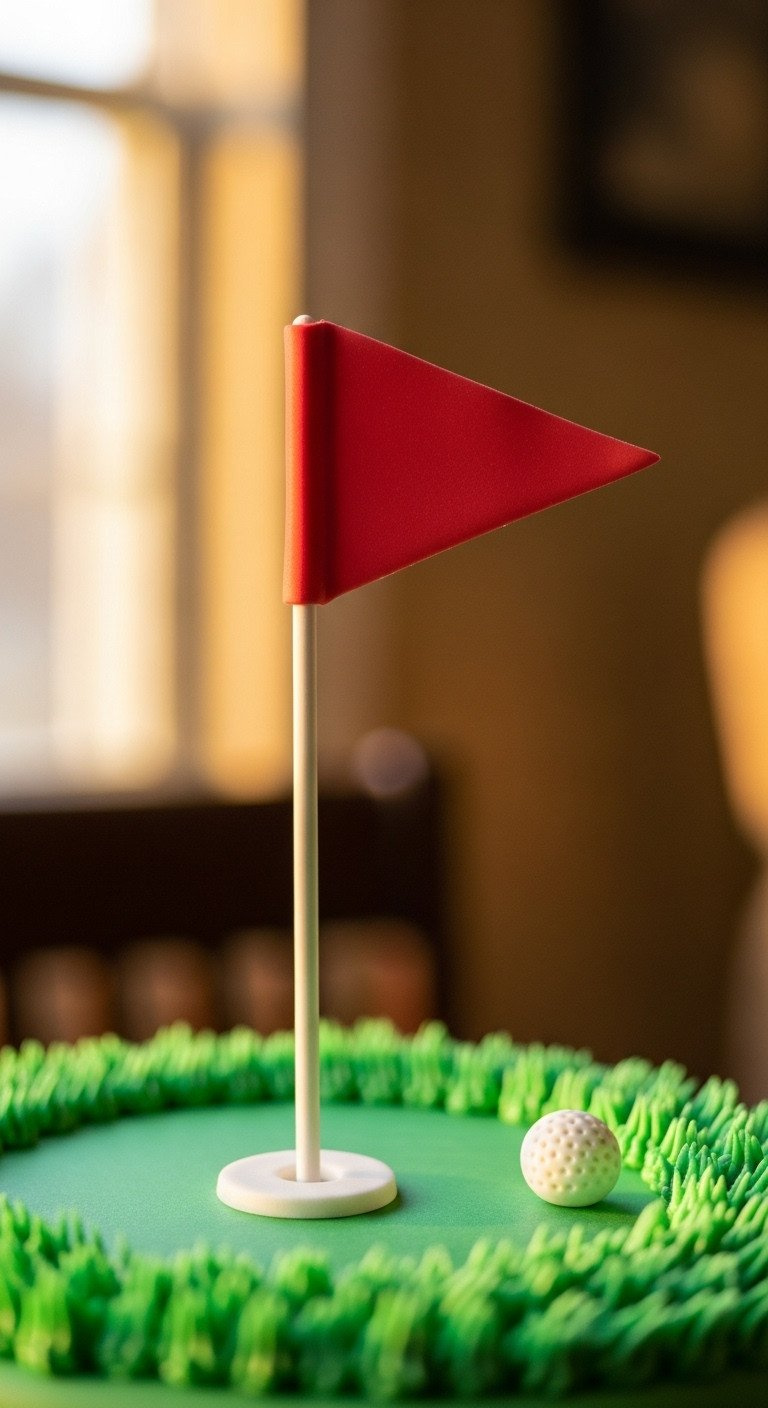
Save this clever organization idea!
A wobbly flag or sliding figurine can ruin the look of your finished cake. Anchoring these elements requires food-safe materials and a strong edible “glue” to ensure they stay upright during transport and display.
Materials Needed:
- Food-grade bamboo skewers or lollipop sticks (for the pin)
- Small edible paper or thin fondant (for the flag)
- Royal Icing or melted white chocolate
- Food-safe plastic figurines/toppers (ensure they are labeled food-grade)
Step-by-Step Directions:
- Prep Pins: If using wooden or bamboo skewers, sterilize them by wiping them clean or dipping the bottom inch in melted white chocolate to create an edible barrier against the wood.
- Measure: Ensure the pin is proportional to the cake (usually 4-6 inches tall for an 8-inch cake) to maintain realism. Attach the flag (edible paper or fondant) using royal icing.
- Anchor Hole: Use a cocktail stick to create a small, neat insertion point in the cake where the pin will go. This prevents the skewer from dragging frosting down.
- Insert: Gently push the flag pin into the prepared hole until it feels secure in the cake layer below.
- Seal Base: For extra security, pipe a small ring of very stiff royal icing or melted chocolate around the base of the pin where it meets the cake. This acts as an edible glue and hides the entry point.
- Figurines: Attach figurines (golf carts, golfers) using a generous dollop of royal icing or melted chocolate on their base for a strong, temporary bond.
Pro-Tip: Never use metallic wire or non-food-grade materials directly in contact with the cake. Use only food-grade sticks, and always inform the recipient that the pin/flag is a non-edible element that must be removed before cutting.
8. Defining Proportional Course Layouts and Boundaries
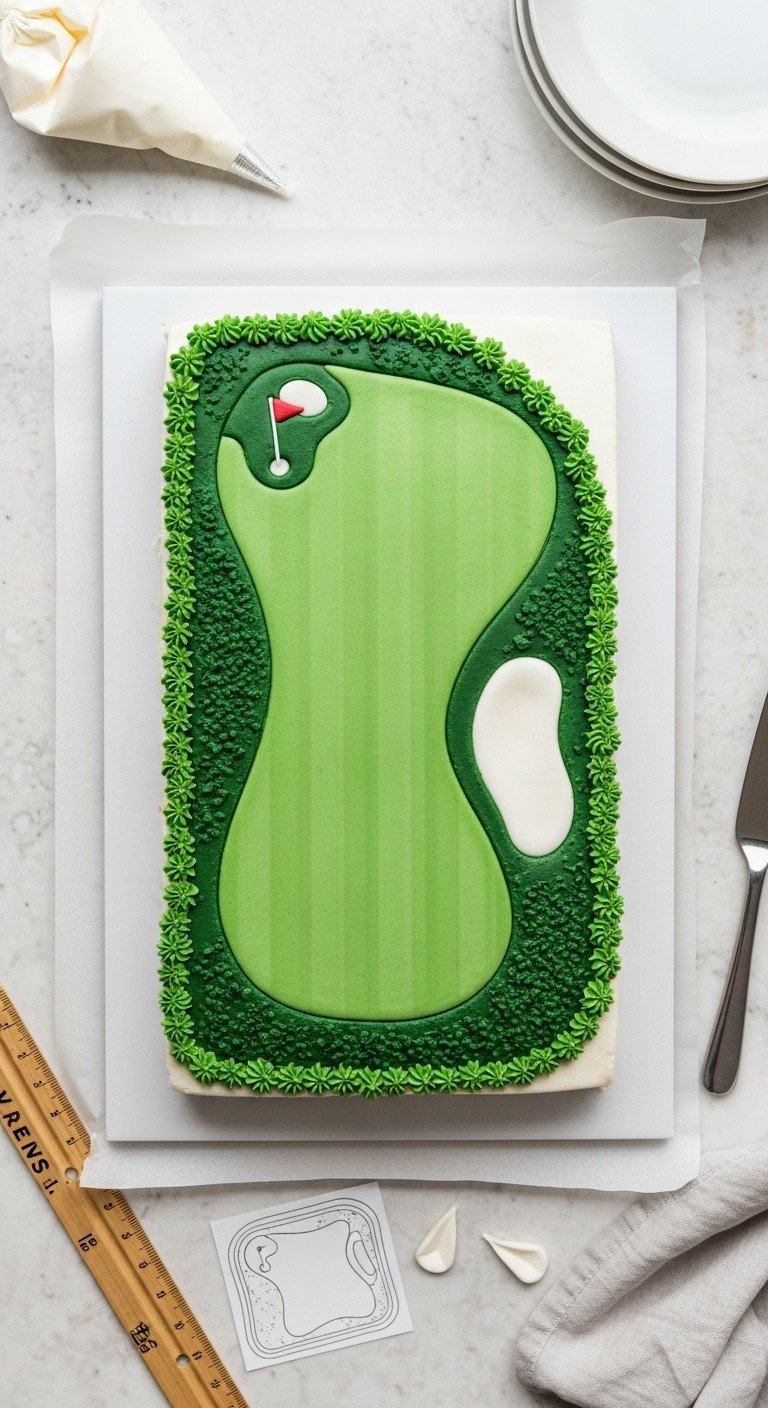
Click to reveal the perfect design blueprint!
A professional-looking cake starts with a good blueprint. Planning the placement of your fairway, green, and sand traps before you start frosting ensures the final design is visually balanced and proportionate.
Materials Needed:
- Parchment paper
- Ruler and compass (optional, for circles)
- Edible food marker (light color, like yellow or light green)
- Crumb-coated, chilled cake
Step-by-Step Directions:
- Sketch: Draw your desired course layout (fairway, green, bunker) onto a piece of parchment paper cut to the size of your cake board. Pay attention to scale—the green should be proportionate to the pin size.
- Mark Points: Place the parchment template over the chilled, crumb-coated cake and gently press a toothpick or pin through the paper to mark the key anchor points (where the green begins, the bunker edges, etc.).
- Connect Lines: Remove the paper and use the edible food marker to lightly connect the marked points, creating the foundational boundary lines directly on the cake surface.
- Prioritize: Always apply frosting to the white/light colored areas (like the bunker borders) first, then the darker colors (green), to simplify cleanup and prevent accidental color mixing.
- Clean Edges: Use an offset spatula or a small round piping tip to apply a firm border of green frosting along the boundary lines, then use the #233 tip to fill in the areas.
Pro-Tip: For the most realistic look, ensure the “green” (putting surface) is a slightly different shade or texture than the “fairway” (main grass area). Use a smoother frosting or a slightly darker green for the putting green if possible.
9. Safe Transport and Storage for a Finished Golf Cake
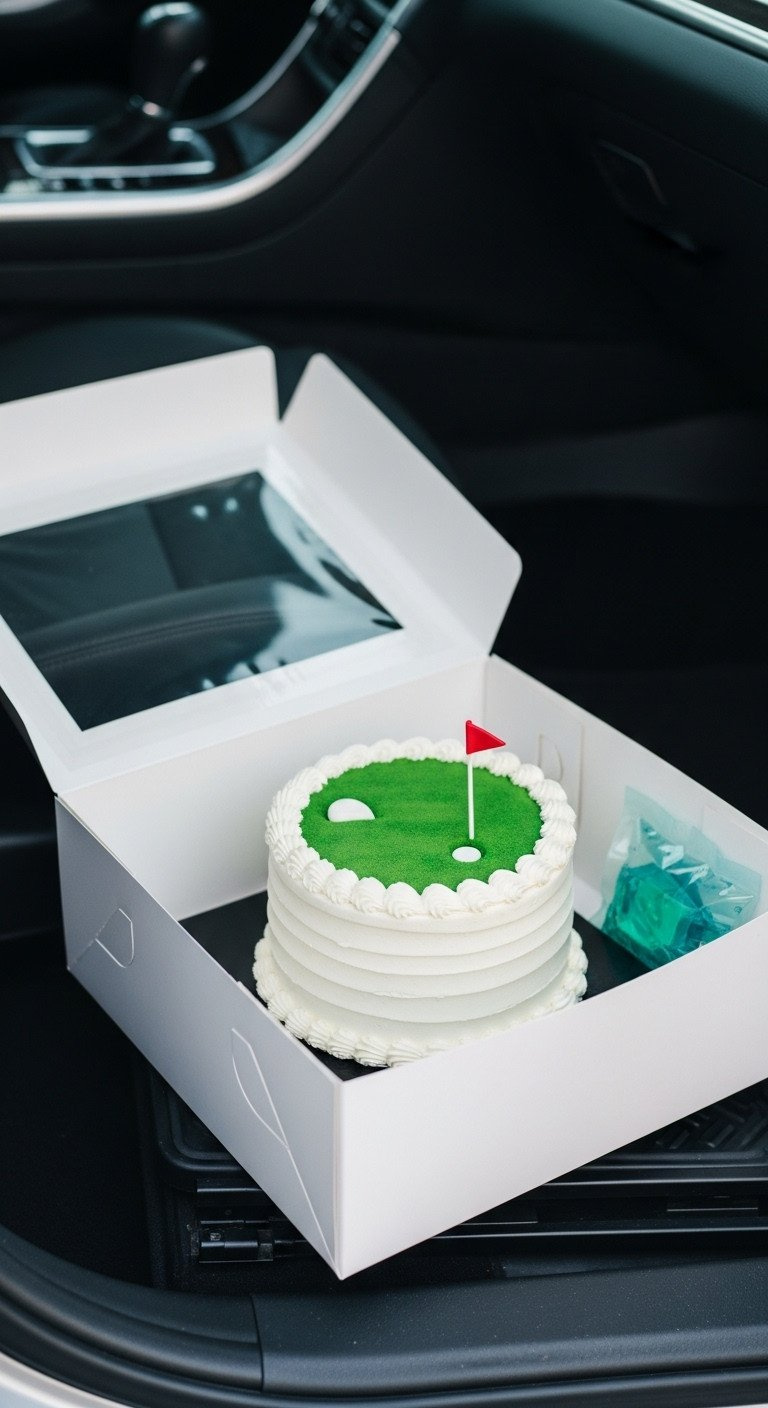
Pin this essential logistics guide!
All your hard work can be undone in a single sharp turn. Transporting a finished novelty cake is the final, crucial step, and it requires careful planning to ensure the masterpiece arrives intact.
Materials Needed:
- Sturdy, appropriately sized cake box (rigid cardboard or plastic)
- Anti-slip shelf liner or mat (cut to box base size)
- Chilled gel packs (for long distances or warm weather)
- Refrigerator/Cooler space large enough for the cake
Step-by-Step Directions:
- Chill Completely: Ensure the fully decorated cake is refrigerated for at least 3-4 hours prior to travel. This allows the stiff buttercream to firm up, making it more resilient to movement.
- Secure the Base: Place the cake onto an anti-slip mat cut to fit snugly inside the transport box. This prevents the entire cake board from sliding during turns and stops.
- Cool Environment: Transport the cake in the coolest part of the car, preferably the flat floorboard area, or secure it in a large cooler if the ambient temperature is over 75°F (24°C). Avoid placing it on a slanted seat.
- Drive Cautiously: Drive slowly, avoiding sudden stops, rapid acceleration, and sharp turns. Treat the cake like a liquid object in transit.
- Storage: Upon arrival, if the cake will not be cut immediately, store it in the coolest, lowest-humidity area possible, preferably a dedicated cake refrigerator or large cooler, away from strong odors. Allow a minimum of one hour for the cake to warm slightly to room temperature before serving for optimal flavor.
Lesson Learned: Never place a large or tiered cake in direct sunlight during transport or display. The heat buildup can compromise the stability of the buttercream and structural components, leading to an immediate collapse risk.
Key Takeaways: Your Quick Guide to Structural Golf Cake Mastery
Here is a quick summary of the most critical techniques for ensuring your golf cake is both beautiful and stable on event day.
- Stability First: For any tiered or heavily carved design, food-grade dowels are non-negotiable for preventing structural collapse during display and transport.
- Master Consistency: Use ultra-stiff American buttercream (with high-ratio shortening) for all grass piping; soft frosting will melt and droop within minutes.
- The Right Tool: The Wilton 233 piping tip is essential for achieving a realistic, textured fairway look with short, rapid bursts of pressure.
- Clean Boundaries: Always chill the cake layers and use a dam of white frosting to create crisp boundaries and prevent dark green color bleed into the lighter areas.
- Safe Travel: Transport the finished cake fully chilled in a secure, non-slip box on the floorboard of a cool vehicle to minimize movement and temperature fluctuations.
FAQs About golf cake
What is the ideal flavor for a golf cake base?
The ideal flavor is a dense, stable cake variety like carrot cake, pound cake, or chocolate fudge. These dense bases offer superior structural support for heavy fondant decorations or multiple tiers compared to light sponge cakes, ensuring stability without sacrificing flavor.
How much does a custom golf themed cake usually cost?
Custom golf cakes typically range from $8 to $15 per slice, with the cost heavily dependent on labor intensity. Designs requiring complex 3D carving, detailed fondant sculpting, or specialized edible image printing will fall on the higher end of the price spectrum due to the professional expertise and time required.
Is it better to use fondant or piped buttercream for the main green area?
Piped buttercream is generally better for the main green area if you prioritize realistic texture and taste. Use the Wilton 233 tip to create a textured, grass-like finish. Fondant, conversely, is better if you require a perfectly smooth, level playing surface like a putting green or if you need to sculpt non-flat terrain elements.
Final Thoughts
Now that you are armed with these piping secrets and structural strategies, you have everything you need to execute a truly fail-proof, professional-quality golf cake masterpiece for your favorite golfer’s next celebration. Focusing on proper chilling, consistency, and internal supports will transform your baking results from amateur attempts to a “Hole-in-One” success.
Which one of these 9 stability secrets are you most excited to try first for your next novelty cake project? Let us know in the comments below
Last update on 2025-11-16 / Affiliate links / Images from Amazon Product Advertising API

